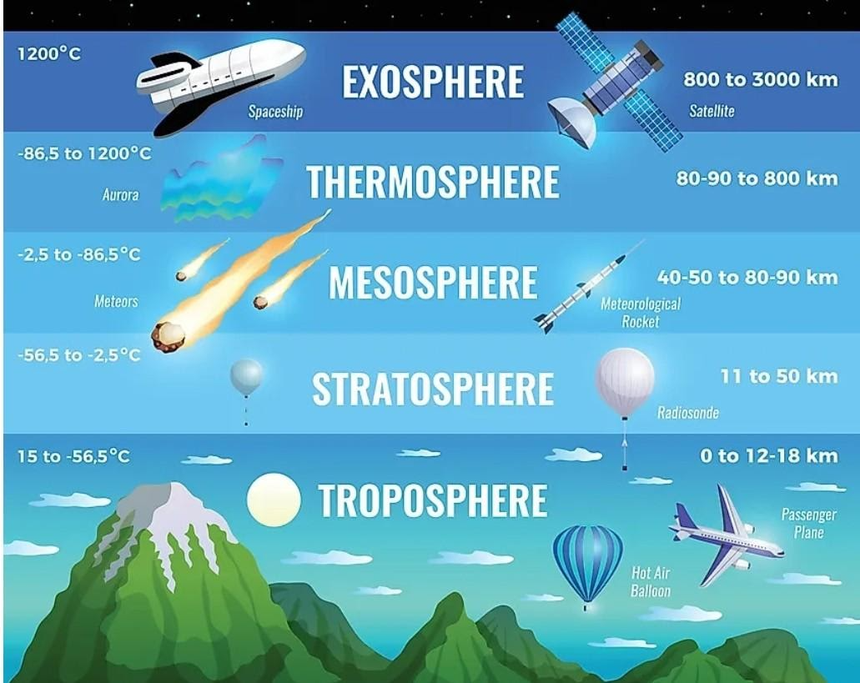Atmosphere - Definition, Layers of Atmosphere, Composition, FAQs
The earth’s atmosphere is a layer of gas that protects the earth from radiation and cosmic radiation. This atmosphere is like a blanket. Atmosphere meaning in Hindi is वातावरण. All the gases in the atmosphere protects the earth. The earth’s atmosphere layers can be divided into 5 layers of the atmosphere. These five layers of atmosphere are: troposphere layer, stratosphere layer, mesosphere layer, thermosphere layer and exosphere layer. All layers of atmosphere are separated by temperature.
JEE Main/NEET 2027: Physics Important Formulas for Class 10
NEET 2025: Mock Test Series | Syllabus | High Scoring Topics | PYQs
JEE Main: Study Materials | High Scoring Topics | Preparation Guide
JEE Main: Syllabus | Sample Papers | Mock Tests | PYQs
- Introduction of Atmosphere
- Troposphere: First Layer of Atmosphere
- Stratosphere: Second Layer of Atmosphere
- Mesosphere: Middle Layer
- Thermosphere Layer
- Exosphere Layer

The most important layer of atmosphere is troposphere. Ozone layer is present in which layer of atmosphere? The layer of atmosphere in which ozone layer lies is known as stratosphere layer and this is the layer in which aeroplane fly. The uppermost layer of atmosphere is exosphere. Atmosphere is the envelope of air surrounding the earth. In this article we will study in detail about the atmosphere, composition of gases in atmosphere, types of atmosphere and components of atmosphere. Also, we will answer to the questions what is atmosphere, what is the meaning of atmosphere, what is troposphere, how many layers of atmosphere are there, what is the composition of atmosphere and what is thermosphere.
Introduction of Atmosphere
Now let us describe atmosphere. Earth is the individual planet well-known to have an atmosphere comprising free of oxygen in abundance, oceans of liquid water on its surface and obviously life. The atmosphere layers play an important role in making life on earth by protecting our Earth from harmful UV radiation of sun. The atmosphere of Earth is the level of gases generally recognized as air that environs the Earth and is engaged by Earth's Gravity. The layers of atmosphere are separated by temperature. Each layer are separated by increasing or decreasing temperature of the gases in the layer.
The earth’s atmosphere is a layer of gas that protects the earth from radiation and cosmic radiation. This atmosphere is like a blanket because it keeps the average temperature of the earth almost constant. The earth’s atmosphere layers can be divided into 5 main layers of atmosphere. Types of layers in atmosphere are: troposphere, stratosphere, middle layer, thermosphere and outer layer.
Also read -
- NCERT Solutions for Class 11 Physics
- NCERT Solutions for Class 12 Physics
- NCERT Solutions for All Subjects
Troposphere: First Layer of Atmosphere
"Troposphere" means change. The name of this layer comes from the weather, which is constantly changing and mixing gases in this part of our atmosphere. This is the lowest atmospheric layer and most important layer of atmosphere. This layer is closest or nearest to the surface of the earth. On average, the atmosphere extends from the ground to a height of approximately 12 kilometres (7.5 miles). Approximately 75% of the air in the atmosphere and almost all the water vapour that makes up clouds and rain are contained in the atmosphere. In this layer, the air is composed of approximately 78.0% nitrogen, 21.0% oxygen, and 1% other gases (including water vapour). The hot air balloon flies in the troposphere. The temperature of troposphere decreases with the increase in altitude.
Also read :
NCERT Solutions for Class 6 Science Chapter 15 - Air Around Us
Stratosphere: Second Layer of Atmosphere
Strat means layer. This is second lowest layer of atmosphere. This layer of our atmosphere has its own layer. The border between the stratosphere and the troposphere is termed as the tropopause. This is the area where the plane flies. The stratosphere extends from the troposphere to approximately 50 kilometres (32 miles) above the earth's surface. This layer contains a thin layer of ozone molecules that form a protective layer and absorb harmful ultraviolet (UV) radiation from the sun. High-altitude elephant balloons fly into the stratosphere to monitor atmospheric conditions and conduct climate research.
Mesosphere: Middle Layer
Meso layer means middle. This layer is found overhead the stratosphere and beneath the thermosphere. It is the third layer of atmosphere and is 35 kilometres (22 miles) thick. The transition boundary separating the middle layer and the stratosphere is called the stratosphere. In the middle layer, fewer air molecules absorb incident electromagnetic radiation from the sun. Most meteors burn in this atmosphere. A meteor is a piece of rock or matter that shatters in space and passes through the atmosphere. As they pass through the middle layer, friction and momentum will cause the meteor to burn and appear as light traveling through the sky.
Thermosphere Layer
Thermo means warmth. This layer has a very high temperature and is located above the mesosphere layer and below the exosphere layer. The air is very thin here. The border between the mesosphere and the thermosphere is termed as the mesopause. It is the coolest part of the earth's atmosphere. The thermosphere extends from the top of the middle layer to 700 kilometres above the earth's surface. The thermosphere is the densest layer in the atmosphere. Only the lightest gases are found here, mainly oxygen, helium and hydrogen. Aurora (Aurora Borealis) and satellites mainly appear in this layer. Aurora is a natural manifestation of light in the sky, especially in high latitudes, caused by the collision of high-energy charged particles with atoms in the high-altitude atmosphere.
Exosphere Layer
Exo means outside, the exosphere represents the outermost bearing of the earth’s atmosphere or highest layer of earth which extends from the top of the thermosphere layer to 10,000 kilometres (16,214 miles) above the earth’s surface. In this layer, particles and molecules outflow into space, and greater satellites orbit our planet.
Let us look at the diagram of different layers of the atmosphere.

Related Topics Link,
- Layers of The Earth
- Lithosphere
- Air Composition Properties
- Importance of Hydrosphere
- Unit of Humidity
What if Earth lost its Atmosphere?
What will happen if there is no atmosphere? Let us answer to this question.
Sound trips to our ears by vibrating air molecules which are existing all around us. Now no atmosphere means that there is no air. Hence there would be complete silence. Secondly, no atmosphere means no oxygen. Life on terrestrial area would not last for other than 5 minutes. But life inside ocean might continue for some time as fishes will use dissolved oxygen to survive. Eventually even that supply will run out. Thirdly, no atmosphere means no clouds. Our sky would lose its magnificent blue colour. It would look just as black as outer space. Fourthly, unfortunately birds can't fly in vacuum. They will drop down to earth without atmosphere. Lastly, without any atmosphere, days would be shorter by 4 minutes while night’s longer as atmospheric refraction advances sunrise by 2 minutes and delay sunset by 2 minutes.
Also check-
Frequently Asked Questions (FAQs)
The atmosphere layers play an important role in making life on earth by protecting our Earth from harmful UV radiation of sun. The atmosphere of Earth is the level of gases generally recognized as air that environs the Earth and is engaged by Earth's Gravity.
Stratosphere
Thermosphere
A meteor is a piece of rock or matter that shatters in space and passes through the atmosphere. As they pass through the middle layer, friction and momentum will cause the meteor to burn and appear as light traveling through the sky.
Stratosphere
Also Read
02 Jul'25 05:02 PM
02 Jul'25 05:01 PM
02 Jul'25 04:59 PM
02 Jul'25 04:49 PM
02 Jul'25 04:46 PM
Articles
Questions related to
Atmosphere:- The blanket of gases surrounding Earth, essential for life.
Types (Layers)
1. Troposhere:- Weather occurs here.
2. Stratosphere:- Ozone layer, jets fly here
3. Mesosphere: Meteors burn here.
4. Thermosphere:- Auroras from here.
5. Exosphere:- Outermost layer, merges into space.
THANKS!!!
Hello Disha,
K.J. Somaiya College of Arts and Commerce stands out for its vibrant campus, strong academic foundation, and experienced faculty who provide valuable guidance. The college emphasizes overall development through extracurriculars like cultural events, sports, and student clubs, fostering creativity and leadership. Its modern infrastructure and supportive learning environment further enhance the student experience.
I hope this answer helps you. If you have more queries, then feel free to share your questions with us, we will be happy to assist you.
Thank you, and I wish you all the best in your bright future.
Correct Answer: low sulphur fuels
Solution : The correct option is low sulphur fuels.
Using low-sulphur fuels decreases the release of sulphur dioxide (SO2) into the atmosphere. The combustion of low-sulphur fuels in vehicles and industrial processes minimizes SO2 emissions, contributing to cleaner air.
Correct Answer: It is the management function of monetary organisation performance.
Solution : Controlling is the management function of monitoring an organization's performance towards attainment of organisational goals. Controlling in the establishment of performance standards, measuring current performance in comparison to established standards, and taking corrective action when deviations are discovered.
Hence, Option C is correct.
Correct Answer: computer models
Solution : The correct option is 4, i.e 'Computer models.'
Explanation:
Consider the fourth sentence of the first paragraph of the passage:
- 'Climate change is frequently portrayed as a prediction made by complex computer models.'
- The preceding line implies that computer models are used to forecast climate change.
Further Information
- A prediction is something that is predicted; a forecast.

